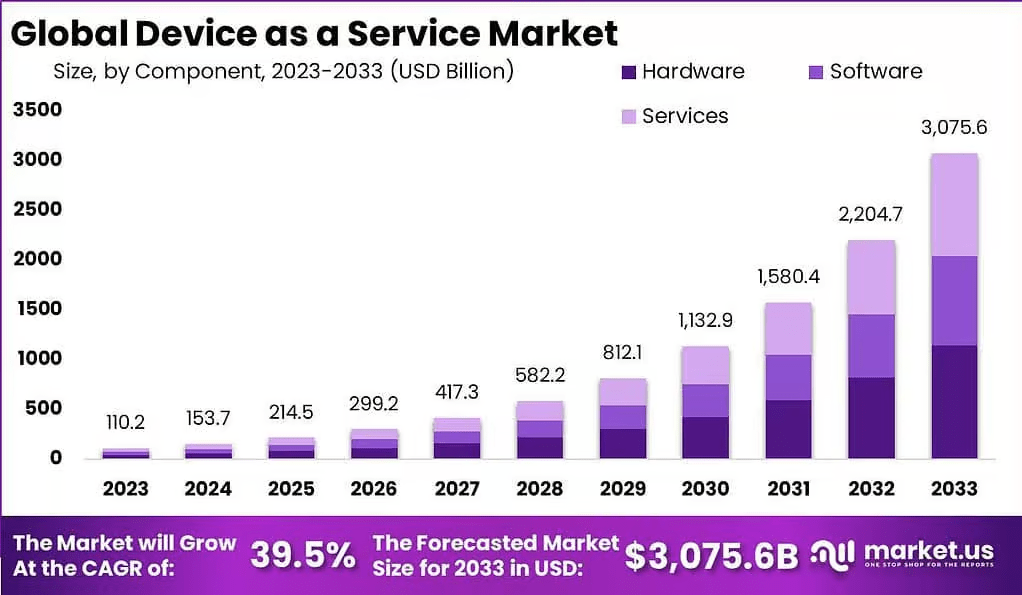Introduction
The Device as a Service (DaaS) Market is transforming how businesses procure, manage, and maintain their IT hardware by offering devices like laptops, desktops, smartphones, and tablets bundled with lifecycle services on a subscription basis. DaaS eliminates the capital expenditure burden, simplifies IT asset management, and enhances flexibility in scaling up or down based on changing organizational needs. As remote and hybrid work environments become the norm, enterprises are increasingly turning to DaaS solutions to ensure streamlined device provisioning, improved security, and end-user productivity without the overhead of ownership.

Key Takeaways
DaaS is gaining momentum due to the rising need for cost-effective, scalable IT infrastructure, especially in sectors such as IT & telecom, BFSI, healthcare, and education. Key market drivers include the shift to remote work, increasing device complexity, and the desire for predictable operating expenses. Organizations benefit from faster device deployment, reduced downtime, and centralized control over updates and security. Small and medium-sized businesses are also adopting DaaS to access premium hardware without heavy upfront investments. The global market is expected to witness robust growth, with North America leading in adoption, followed by rapid expansion in Asia-Pacific.
Component Analysis
The primary components of the DaaS model include hardware (devices), software and management platforms, and support and maintenance services. Hardware typically comprises end-user computing devices such as laptops, tablets, and smartphones. The software component includes remote management tools, device analytics, security solutions, and OS licensing. Management platforms enable centralized configuration, patch management, and compliance enforcement. These components work in tandem to deliver a seamless user experience while allowing IT departments to monitor and manage device fleets proactively.
Service Analysis
DaaS providers offer a range of services including device provisioning and configuration, asset lifecycle management, tech support and helpdesk services, device security and monitoring, and recovery and refresh services. Subscription-based service models allow organizations to tailor solutions to their specific needs—ranging from short-term device rentals to full-scale enterprise deployments. Providers also deliver end-to-end logistics, warranty management, and recycling or buyback programs to align with sustainability goals. Increasingly, AI-driven analytics and automation are being integrated into service offerings for predictive maintenance and optimized resource allocation.
Key Player Analysis
Leading players in the DaaS market include HP Inc., Dell Technologies, Lenovo, Microsoft, Apple, Citrix, and Amazon Web Services (AWS). HP and Dell are pioneers in offering full-stack DaaS solutions, combining hardware, software, and services with global reach. Lenovo provides flexible DaaS options with a strong emphasis on endpoint security and global logistics. Microsoft’s Surface-as-a-Service integrates hardware with Microsoft 365 and cloud tools, while Apple partners with service providers for device leasing solutions tailored for education and creative industries. Citrix and AWS offer complementary DaaS infrastructure for virtual desktop environments, enhancing remote work capabilities.
Top Market Leaders
- HP Inc.
- Dell Inc.
- Lenovo Group Limited
- Microsoft Corporation
- IBM Corporation
- Cognizant
- Accenture plc
- Acer Inc.
- Apple Inc.
- Cisco Systems, Inc.
- Intel Corporation
- CDW Corporation
Conclusion
The Device as a Service model is revolutionizing enterprise IT by shifting hardware ownership into a service-driven, flexible subscription framework. As digital transformation accelerates and workforces become increasingly mobile, DaaS provides a strategic path to reduce costs, boost productivity, and simplify device management—ushering in a new era of efficient, scalable, and sustainable IT consumption.
The macro analyst desk brings highly sought after financial news based on market analysis, insider news and company filings.
